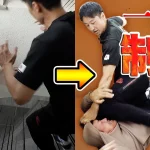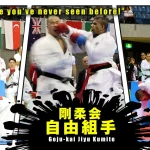Roy Goldberg Sensei’s Shugyo: Passing On Daito Ryu Aikijujutsu Kiyamakai
Japanese interview and composition by Satoshi Kato
English translation by Matthew Noyes
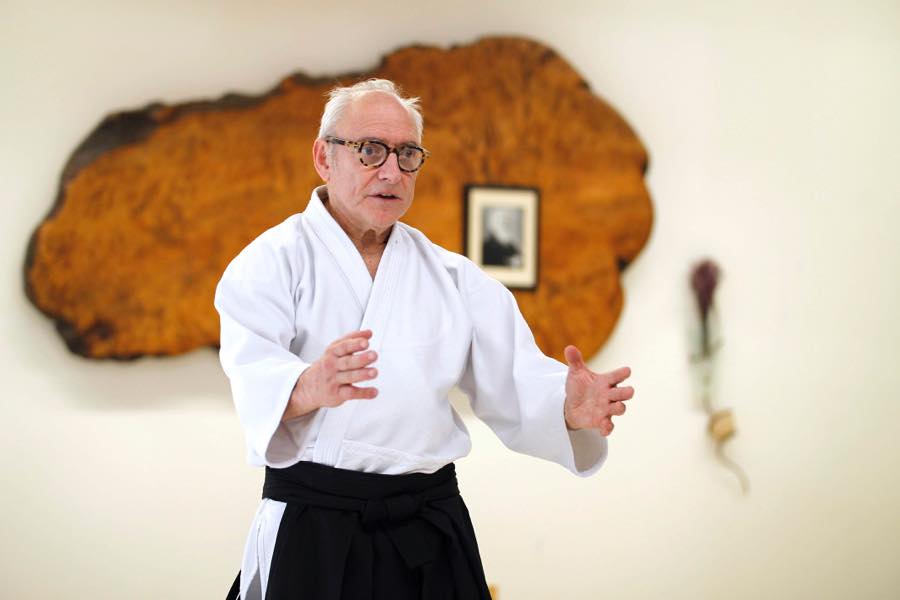
Daito Ryu has always been about the pursuit of “Aiki,” of developing the body and constantly refining technique. Unfortunately, so much about this art and how to develop in it has been kept a secret and hidden, lending to the possibility of the substance of the art disappearing altogether. Roy Goldberg Sensei, however, is determined to pass on the art to future generations by holding public seminars and openly teaching serious students who earnestly seek to learn. Formerly affiliated with Kodokai, he is one of the highest-ranking non-Japanese practitioners of the art, having received the Kyoju Dairi (Representative Instructor), seventh dan, and Hi Ogi, the third Scroll in the Daito Ryu transmission. Hiden Magazine interviewed Goldberg Sensei, based out of Connecticut, about his desire to spread and deepen Daito Ryu Aikijujutsu.
Discovering Daito Ryu
Q: Tell us about your martial arts background.
Roy: I started out training in Miyama Ryu Jujutsu, an eclectic system of aikido, judo, and karate under its originator Shinan Antonio Pereira in the Bronx. We would do things like turn all the lights off and train with live knives in the dark. That might seem extreme but it suited me at the time.

Goldberg Sensei (on the left) at the Miyama Ryu Jujutsu Dojo.
Q: What about after that?
Roy: I started attending Daito Ryu Kodokai seminars that Katsumi Yonezawa Sensei would hold on the East Coast. I was deeply impressed by his uke Hayawo Kiyama Sensei (Currently Chief Instructor for North American Daito Ryu Aikijujutsu Kodokai). Yonezawa Sensei had very hard jujutsu, but Kiyama Shihan was subtle and soft. When I first grabbed Kiyama Sensei I felt something different from any other martial artist I had ever trained with. Kiyama Sensei invited me to train with him and took me on as his student after he saw that I kept showing up at the seminars. Once I became his student I flew out from the East Coast regularly to train with him in California. Most of my training with Kiyama Sensei has been in his home, jikiden training (direct transmission).
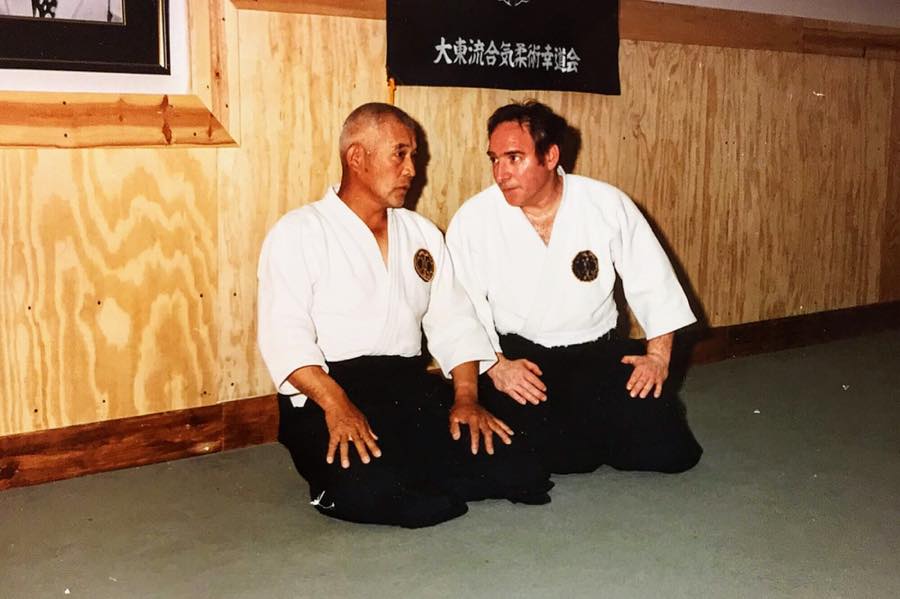
Kiyama Shihan and Goldberg Sensei.
Q: Did you train in Japan as well?
Roy: After Kiyama Shihan accepted me as his student, we would go to Japan together to train at the Kodokai for a couple of weeks at a time. Looking back, it was probably actually good that I didn’t speak Japanese because I could concentrate on feeling the technique and observing external movement. Sometimes people say one thing but they’re really doing something else. Traveling to Japan as much as I did was a great opportunity for me though because I had the chance to train with most of the shihan who were with Kodokai at the time. I was especially influenced by Kato Tomiharu Shihan and of course Inoue Shihan the Menkyo Kaiden.
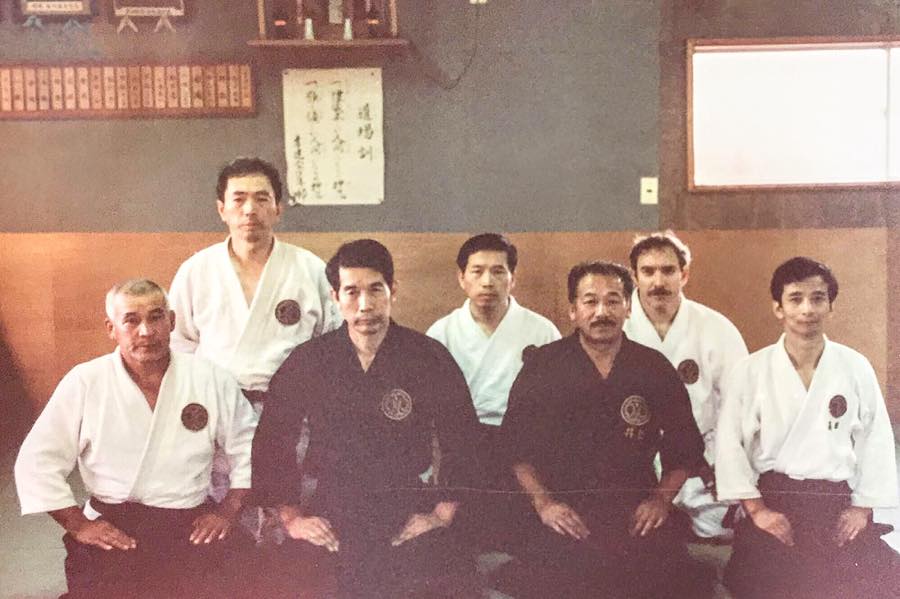
Kodokai commemorative photo
Q: Was Seigo Okamoto Sensei part of the Kodokai at that time?
Roy: I think he was part of Kodokai when I first started training but my clearest memory of Okamoto Sensei is when I attended a seminar he was holding in California. I went with Kiyama Shihan to look for any differences or similarities between Okamoto Sensei’s and our Daito Ryu as he used to be affiliated with Kodokai. I think some of his techniques changed after he went independent and started the Roppokai.
Q: Tell us about Yusuke Inoue Shihan
Roy: I am especially grateful to Inoue Menkyo Kaiden for training with me when I would travel to Japan. We trained a lot together, especially alone and off the mat. He would show me techniques that I rarely saw in Kodokai or even other Daito Ryu styles. Over my 35 years in the Kodokai I had the opportunity to train a lot in Japan which included working with Inoue Shihan. As of 2017 I left Kodokai and now run my own organization, which I named after my teacher Kiyama Shihan.
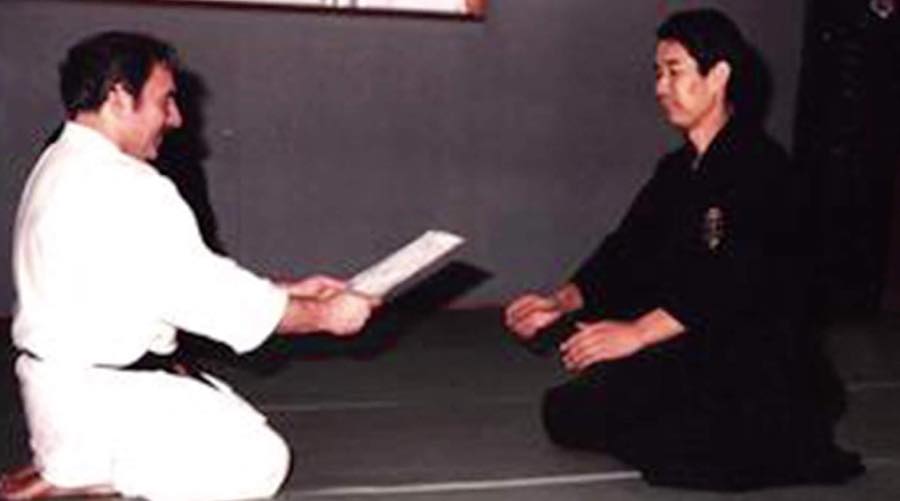
Inoue Shihan awarding Goldberg Sensei with his Oku San Dan

Kiyama Shihan presenting Goldberg with the third scroll, the Hi Ogi
Different Teaching Styles in Daito Ryu
Q: What makes Daito Ryu unique from other arts?
Roy: It’d be easier to show you some of the differences between Daito Ryu and Aikido or other schools of jujutsu than to explain it. (Goldberg Sensei proceeded to demonstrate the usual Ikkajo pin often seen in Aikido and other schools of jujutsu. The technique is usually done by holding the back of the opponent’s hand and locking the wrist. However, what Goldberg Sensei showed was to hold the base of the opponent’s index finger with your own and to apply pressure from your center by entering in through the opponent’s index finger into his body.) You want to make sure the uke really can’t get up or resist the pin, something that Inoue Shihan emphasized to me.

Goldberg Sensei drawing his uke into Aiki Age.
I take that a step farther in our training, and emphasize with my students that uke’s role isn’t to make the tori look good, even when it’s the teacher doing the technique. It’s important for the uke to react naturally. I make sure my students know not to take a fall or a roll for each other or for me just because you’re “supposed” to take ukemi. You should only take ukemi when you have to, when the technique works and you have no choice but to go. Now of course, there are exceptions. As uke you may have to adjust to your partner’s level, especially at the beginning. Or if it’s a teacher that you don’t have that kind of relationship with you can take ukemi and say to yourself that was good or it wasn’t quite successful and keep that to yourself. But, when I’m doing a seminar or training privately with students I want them to give me serious committed attacks and have a genuine response. How else can I learn? I even ask my students for feedback. What did that feel like? Did the technique feel better the first time or the second time? You can’t grow as a martial artist if you get satisfied with where you’re at at any given time.
Q: Do you go into teaching and explaining some of the more subtle and higher-level aspects of techniques?
Roy: Yes I do. Often instructors in the Kodokai would just show the techniques without really sharing what’s going on beyond the surface. My teaching method isn’t just to demonstrate but to explain everything down to the mechanics so that everyone can get it. Now, most people don’t understand it at the beginning, but eventually they do. So, it isn’t really a secret. It just takes shugyo to learn. For example, Aiki Age contains various principles of the entire art of Daito Ryu and of Kodokai’s style of Daito Ryu. So that’s something we often start with because it’s essential for students to get it if you want to pass on the whole art and not just empty techniques. And eventually, the students have to be able to teach it otherwise the art will eventually die out. So, I place a lot of emphasis on teaching instead of just showing to help my students develop.
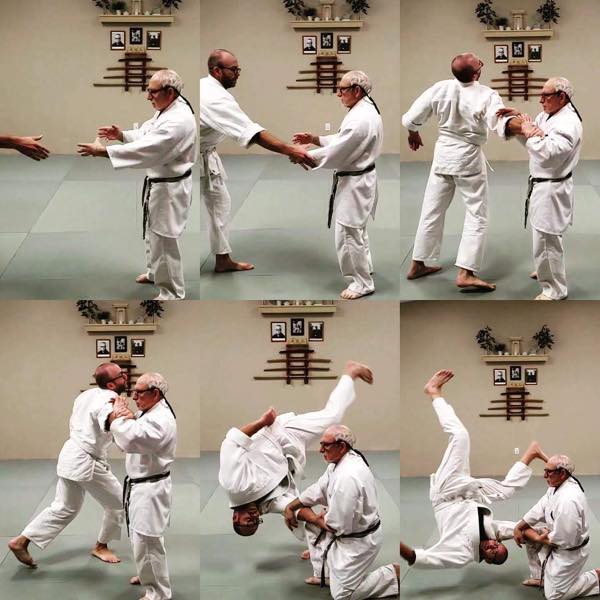
A series of photographs of Goldberg Sensei performing a technique.
Q: Kiyama Sensei’s way of teaching is also distinct, right?
Roy: I think the fact that Kiyama Shihan went overseas away from Japan lent to his technique being so good. In Japan, you get very few people that are physically large. I think that being in the U.S. helped Kiyama Shihan develop his technique because he had to find a way to make his technique work with people of all different sizes, including people that were much larger than him. That certainly lent to his teaching as well.

Kiyama shihan and Goldberg Sensei
Q: What do you value most in teaching?
Roy: When it comes to teaching the most important thing is that the teacher passes on what he has to his student, that the students then becomes a teacher himself, and that he then passes it on to the next generation. What’s the point if I figure it out but the art dies with me? It has to be a living art that doesn’t end with just you getting it. Training a student is like watering and nurturing a plant. You have to keep watering them (with technique, body development, and explanation) in accordance with their different stages of development. Otherwise, they and the art wither away.
Aiki, development, and feel
Q: Daito Ryu has a reputation of being hard and rigid, is it though?
Roy: Actually, our style tends to be very soft, but the fall can feel hard to the uke. But, whether or not Daito Ryu is hard or soft isn’t really the issue. At first we tend to focus a lot on how to move our body and the outward appearance of the techniques. But performing the technique doesn’t really have much to do with “hardness” or “softness.” What’s important is the essence of the technique and and how you connect to uke. For example in aiki age you put your hands out and the uke grabs your hands. You then proceed to enter into them. Even when you run into the opponent’s strength and mass you have to remain totally immovable. By keeping your intention forward you can end up floating the uke off the ground. It’s very important that once you’ve entered you stay solid and immovable, but not rigid.
Until now, teaching in Daito Ryu teaching has consisted almost exclusively of demonstrating techniques. But Daito Ryu is a system of body development and techniques that require the same precision as mathematics so there needs to be some explanation and teaching involved. This is something that is sometimes missing when Daito Ryu is taught.
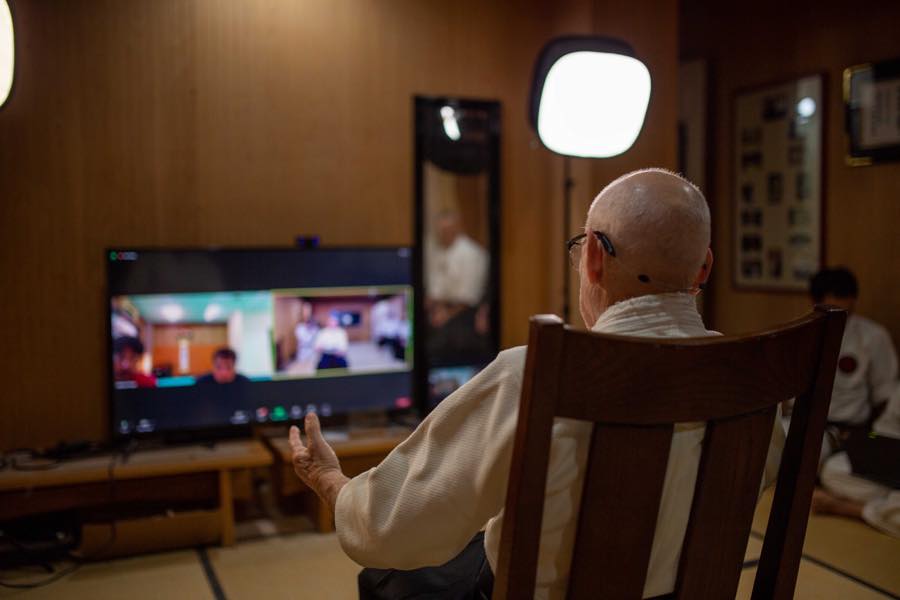
Goldberg Sensei Zooming into the interview from his home dojo in Connecticut.
Q: How do you train?
Roy: Kiyama Sensei always says “shugyo is everything” (he would also note that “everything is shugyo”!). I work with my students as much as I can, but you can’t always be on the mat in the dojo. So, I try to practice my Daito Ryu in how I move my body and in everything I do throughout the day. I do rock climbing where I have to use every part of my body to mold to the rock. I do horseback riding, where my uke weighs 1,000 pounds and responds to the subtlest movement. Most of all I also practice kyudo, with Phil Ortiz, who is just amazingly talented and knowledgeable, he was a student of Heki Ryu’s Shibata Sensei. I believe kyudo has the most in common with Daito Ryu. Using your body to open in each direction while maintaining tension from your hara, the use of breath, the internal alignment, all are very similar.

Goldberg Sensei demonstrating a variety of techniques during the interview.
Q: Is there a stage beyond just learning the movements of the techniques?
Roy: As you progress further, it becomes important to capture the opponent like you are swallowing him and taking all the slack out. To start to develop this you need to practice slowly. People won’t get this or every concept from the beginning but as you practice you come to understand them. Kiyama would say, “Shugyo, shugyo, shugyo.” You need to train to get this and training doesn’t just happen in the dojo. Even when I go on walks with my wife and hold hands I try to make a connection and do techniques on her subtly (To which Sensei and everyone at the interview proceeded to laugh).
Even just the way you reach for your coffee cup can have Daito Ryu in it. I don’t hide anything from my students who are serious about training. Developing Aiki requires both a student who really wants to learn and a teacher who really wants to teach. Even then there are few who are serious enough to put in the work required to learn this and even fewer who understand Aiki enough to teach it.
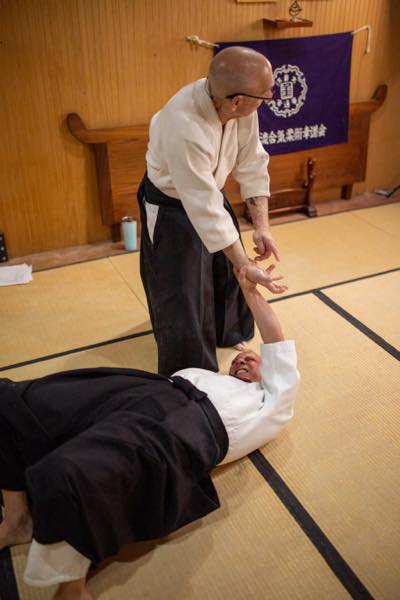
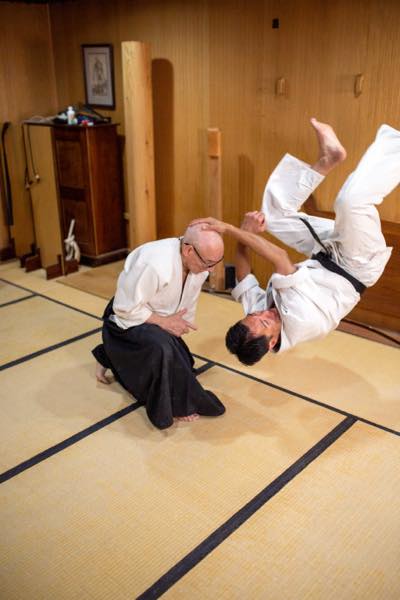
Passing on Aiki to the next generation
Q: What are your goals for the future?
Roy: My mission is to pass on Aiki to the next generation. What’s the point if I’m the only one who gets it? I don’t just sit by and watch my students train; I make sure that they learn what I have as well.
One of the strong points of our organization, Kiyamakai, is that we teach everything from the basic attitude one should have toward training to the details of techniques and developing the body. We don’t keep it a secret. If you keep a secret for long enough you end up losing it. Whether the student “hears it” though and then practices is ultimately up to them.
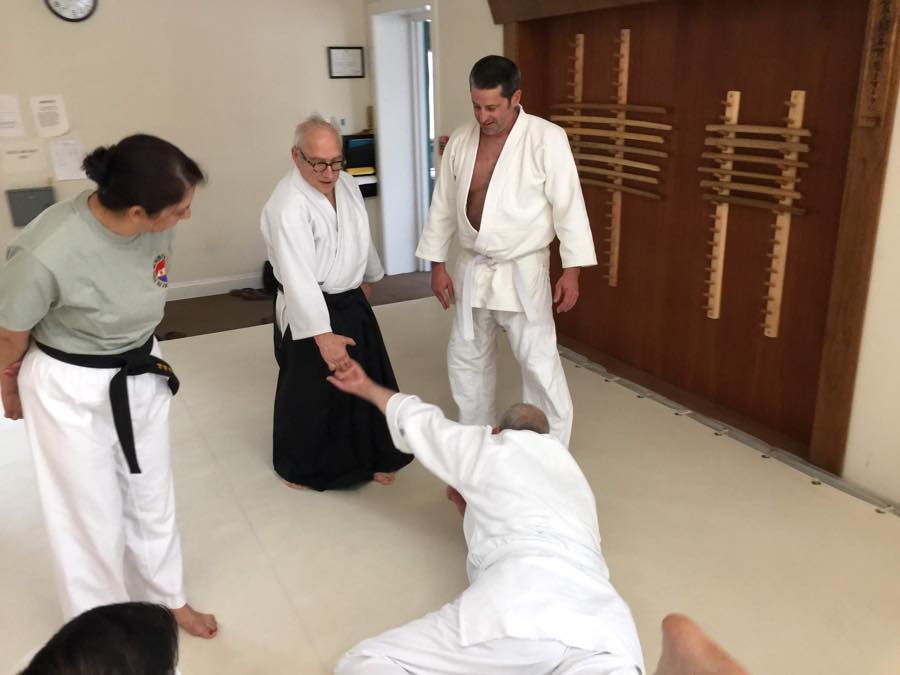
Goldberg Sensei immobilizing his uke, a technique reminiscent of Kodo Horikawa Sensei.
Q: Did your background as a physical therapist have an impact on your martial arts training?
Roy: Because of my profession I intuitively know how much range of motion a joint has and where it can break. There is always a limit to the range of motion of a joint, so I understand the need to be careful even with flexible people. More importantly, physical therapists are constantly in contact with people during their work, which is in itself a type of training. Feeling is very important though. I don’t “think” about my physical therapy training from when I bow in at the dojo to when I bow out. I also don’t analyze techniques when I’m training. Beginners inevitably think about posture, angles, and other things too much, but Aiki is not in the mind it’s in the body. If you try to analyze it by thinking about it, you will lose your connection.
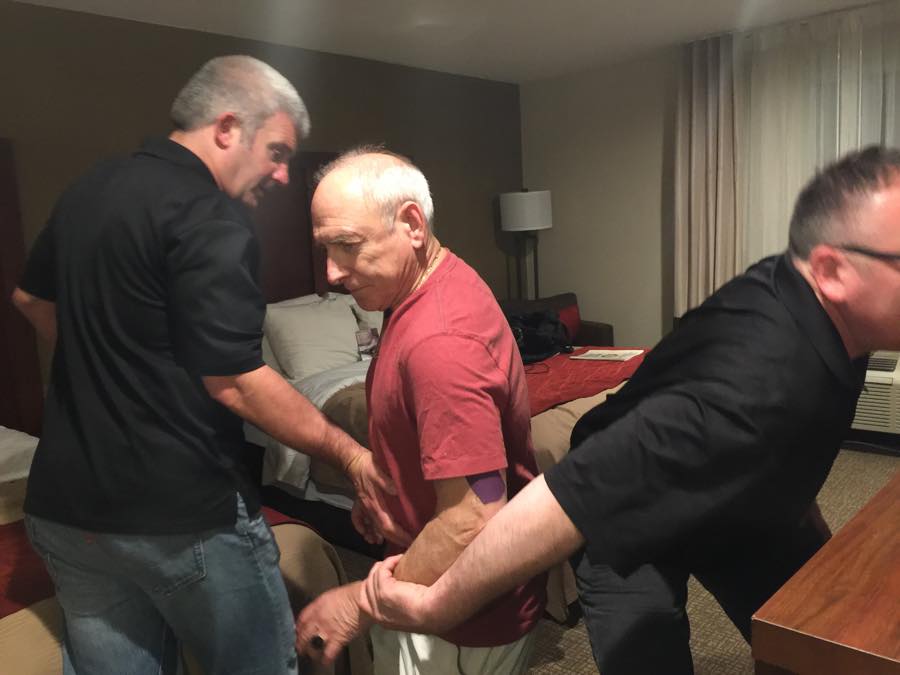
Goldberg Sensei transmitting what an Aiki body should feel like to his students.
Q: Is it difficult to pass on Aiki?
Roy: When I would train in Japan with Inoue Shihan there were times it was difficult for me to learn from him because, unlike me, he’s tall. He told me that when he was young, he had trouble learning from Horikawa Meijin because Horikawa was short. So, I’ve always tried to teach in a way that isn’t exclusive to certain body types. Now I feel I’m able to teach regardless of differences in size between a student and myself.
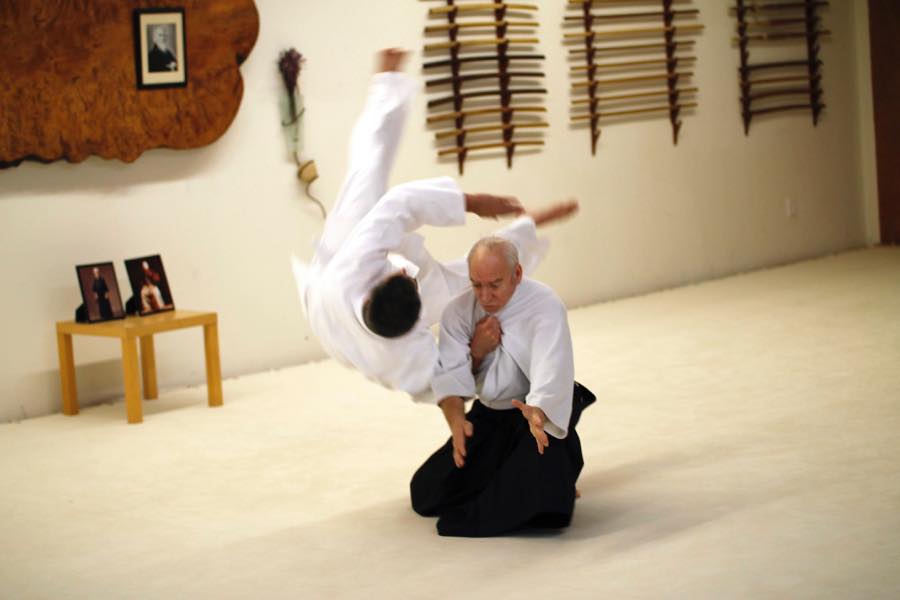
My main purpose behind doing this interview was to share how much I love this art and want to pass it on. Kiyama Shihan is truly a martial arts genius. In my opinion, his skills were superior to those of anyone else I have ever met. I was very fortunate to have studied under him and to continue to have a close relationship with him. However, Kiyama’s teaching style was to show you the techniques and teach you just a little bit. Other than that little hint, you had to figure it out on your own. I think it would be very difficult for most people to learn under Kiyama Shihan. He doesn’t often give complements. So, when he finally started saying in front of people at seminars, “Goldberg real shugyo student. Shihan techniques this one!” it gave me more confidence to pass the art on. I teach about half of the principles in a technique and then help students work out the other half for themselves, rather than just showing them a little and leaving it all to them to find the rest. Sometimes martial artists from other Daito Ryu schools come to train with me. They’ll often say, “Goldberg Sensei is completely different from other Daito Ryu teachers.” In part I think this is because my Aiki feels different than others, but the major difference is because my teaching style is unique. I openly talk about aspects of the art like the need to not resist with muscle power and instead enter into the opponent. This is an important factor common to every technique. Some schools will keep things like that a secret but I don’t consider it a secret. My dream is that this wonderful art will live on and not be lost, that it will continue to be passed on in perpetuity after I am gone and I am so grateful that I have people like my senior student Manny Jimenez who has been with me for more than 20 years. Manny has been able to assimilate all these techniques and in ways can do some things even better than me! I am so impressed by my Study Group heads like Jason Martinez, Tony DiSarro, Dave LoPriore, Marty Brzykcy, John Sorensen. And I look at that next generation with students like Charlie Siegel, Jack Bieler, Erwin Ricafort, and Hung Le (who travels with me all the time because he loves it so much!). And now, we have a new Study Group in Tokyo headed by Matt Noyes, who I’m really looking forward to seeing with the seminar in May, 2023.
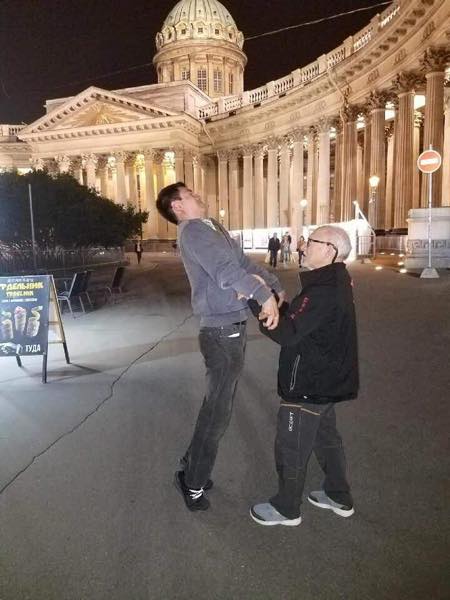
Practicing outside after teaching a seminar in Russia.
Q: Did you always have the idea to teach openly without being secretive?
Roy: Well, in the beginning I didn’t understand Daito Ryu at all, and I didn’t even think about teaching it. However, as I got more shugyo under my belt and improved my skills, I started to… Well, it’s like Shu-Ha-Ri so to speak, and I think I might be in the “Ri” stage now.

Goldberg Sensei with some of his students outside his home dojo.
Q: Thank you for letting us interview you.
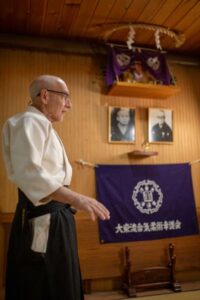 Roy Goldberg
Roy Goldberg
Roy Goldberg Sensei grew up in the Bronx, New York in the 1950s. As a boy, he played sports like baseball and learned boxing from his father. Before studying Daito Ryu under Hayawo Kiyama Shihan, the Chief Instructor for North American Daito Ryu Aikijujutsu Kodokai, he studied Miyama Ryu Jujutsu under its originator Shinan Antonio Pereira for thirteen years in the Bronx and trained in Aikido at the New York Aikikai for some time. Since then, he has trained with Kiyama Shihan for over 40 years, with many visits to Kitami in Hokkaido to train with the Kodokai Menkyo Kaiden Yusuke Inoue. Inoue Shihan and his direct teacher Kiyama Shihan awarded Goldberg Sensei seventh dan and the Kyoju Dairi. In June 2016, he became the first non-Japanese to be awarded the Hi Ogi No Koto, the third scroll in the Kodokai tradition by the Kodokai Hombu Dojo. In 2017 he left the Kodokai and became independent, though he still considers Kiyama Shihan to be his teacher. He now has authorized study groups and holds seminars throughout the U.S.
・Daito Ryu Aikijujutsu Kiyamakai Home Page https://daitoryuaikijujutsu.net/
・Tokyo Study Group https://daitoryutokyo.com/
・Goldberg Sensei’s YouTube Channel https://www.youtube.com/user/aikishingen/videos
・Goldberg Sensei will be teaching a seminar in Tokyo on May 6 and 7, 2023. Please refer to the Kiyamakai Tokyo Homepage for details.








